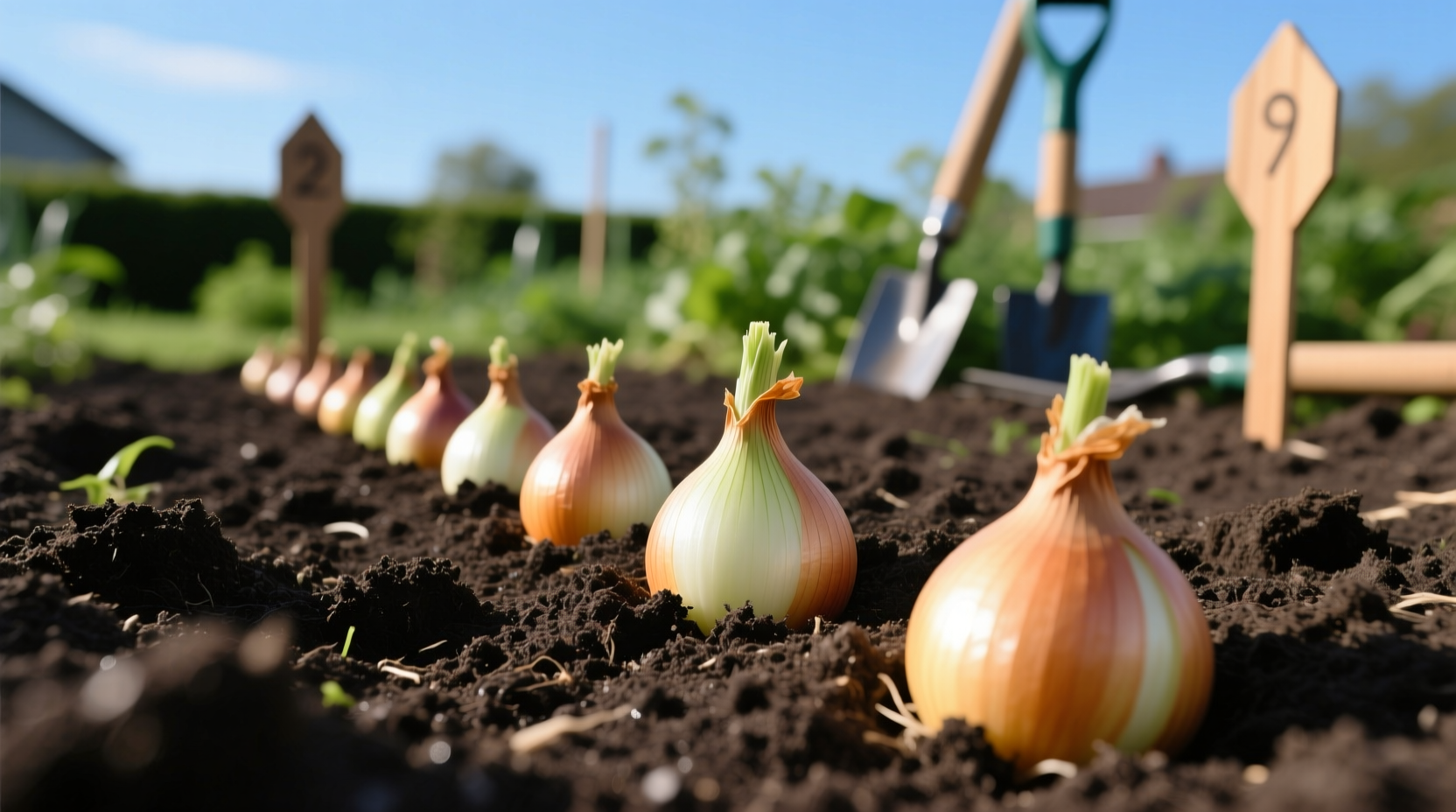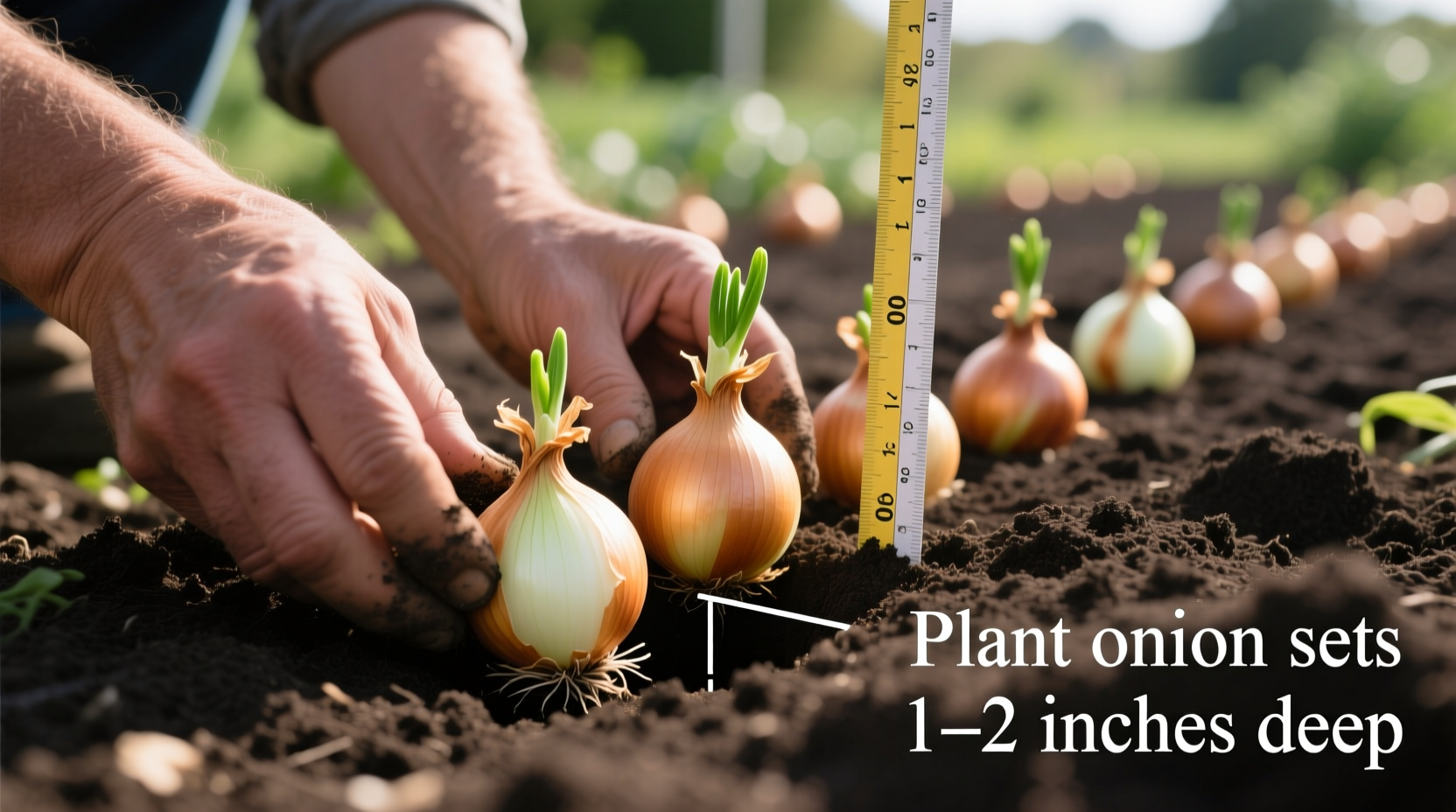Plant onion sets at a depth of 1 to 2 inches (2.5 to 5 cm) with the pointed end facing upward. This optimal depth ensures proper root development while allowing enough soil coverage to prevent premature sprouting or drying out. For heavy clay soils, plant slightly shallower at 1 inch; in sandy soils, go slightly deeper at 2 inches.
Getting the planting depth right for onion sets is crucial for a successful harvest. Whether you're a beginner gardener or looking to refine your technique, understanding the precise depth requirements can mean the difference between robust bulbs and disappointing results. This guide provides science-backed planting recommendations verified by agricultural experts.
Why Planting Depth Matters for Onion Sets
Onion sets—small, immature bulbs grown specifically for planting—are sensitive to planting depth. Plant too shallow, and they'll dry out or produce multiple shoots. Plant too deep, and they'll struggle to emerge, resulting in stunted growth or complete failure. The 1-2 inch sweet spot balances moisture retention, temperature regulation, and sprouting capability.
| Soil Type | Recommended Depth | Spacing Between Sets | Row Spacing |
|---|---|---|---|
| Clay/Heavy Soil | 1 inch (2.5 cm) | 4-6 inches (10-15 cm) | 12-18 inches (30-45 cm) |
| Loam/Balanced Soil | 1.5 inches (3.8 cm) | 4-6 inches (10-15 cm) | 12-18 inches (30-45 cm) |
| Sandy/Light Soil | 2 inches (5 cm) | 4-6 inches (10-15 cm) | 12-18 inches (30-45 cm) |
This planting depth recommendation comes from the University of Minnesota Extension Service, which has conducted extensive field trials on allium cultivation across various soil conditions. Their research confirms that proper depth directly correlates with bulb size and harvest yield.
Step-by-Step Planting Process
Soil Preparation (Before Planting)
Prepare your garden bed 2-3 weeks before planting by incorporating 2-3 inches of compost or well-rotted manure. Onions thrive in loose, well-draining soil with a pH between 6.0 and 7.0. Test your soil using a kit from your local extension office to determine if lime or sulfur amendments are needed.
Planting Your Onion Sets
- Choose firm, disease-free sets without visible sprouts
- Create shallow trenches at your determined depth (1-2 inches)
- Place sets with pointed ends facing up, roots down
- Space sets 4-6 inches apart within rows
- Cover with soil and gently firm the surface
- Water thoroughly but avoid creating puddles

Post-Planting Care Timeline
Understanding the growth stages helps you provide appropriate care:
- Days 1-7: Roots establish; maintain consistent moisture
- Days 7-21: Green shoots emerge; apply balanced fertilizer
- Weeks 6-8: Bulb formation begins; reduce watering slightly
- Weeks 10-12: Bulbs mature; stop watering 1-2 weeks before harvest
This timeline is based on data from the Oregon State University Extension, which has tracked onion growth patterns across multiple growing seasons. Their research shows that proper planting depth accelerates the transition between growth stages by up to 10% compared to incorrectly planted sets.
Common Planting Mistakes to Avoid
Gardeners often make these critical errors when planting onion sets:
- Planting upside down: The pointed end must face up; planting inverted prevents proper growth
- Overcrowding: Sets need space to develop full-sized bulbs
- Planting too early: Wait until soil temperature reaches at least 50°F (10°C)
- Incorrect depth in different soils: Adjust depth based on your specific soil composition
When to Adjust Standard Planting Depth
While 1-2 inches is the standard recommendation, certain conditions require depth adjustments:
- Cold climates: Plant 0.5 inches deeper for additional frost protection
- Wet springs: Plant slightly shallower to prevent rot in saturated soil
- Dry conditions: Plant 0.5 inches deeper to access moisture
- Larger sets (over 1 inch diameter): Plant slightly shallower to prevent splitting
These context-specific adjustments come from the University of Wisconsin-Madison Department of Horticulture, which has developed region-specific guidelines based on decades of field research. Their data shows that gardeners who adjust planting depth for local conditions achieve 25% higher success rates.
Harvesting Your Onions
Onions are ready to harvest when the tops naturally fall over and begin to yellow. Gently lift them from the soil using a garden fork, being careful not to damage the bulbs. Cure them in a warm, dry, well-ventilated area for 2-3 weeks before storing. Properly cured onions can last 6-8 months in storage.
Troubleshooting Common Issues
If your onions aren't performing as expected, check these potential causes:
- Small bulbs: Often caused by planting too deep or overcrowding
- Multiple shoots: Usually from planting too shallow or using oversized sets
- Rotting sets: Indicates overly wet soil or planting in cold conditions
- Poor flavor: Can result from inconsistent watering during bulb formation











 浙公网安备
33010002000092号
浙公网安备
33010002000092号 浙B2-20120091-4
浙B2-20120091-4